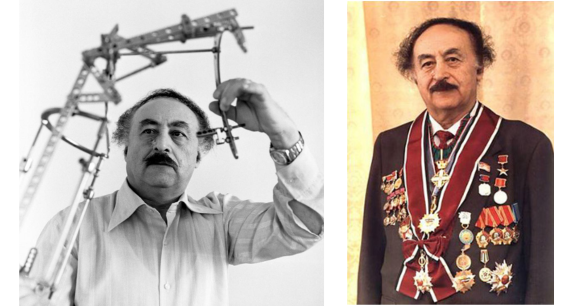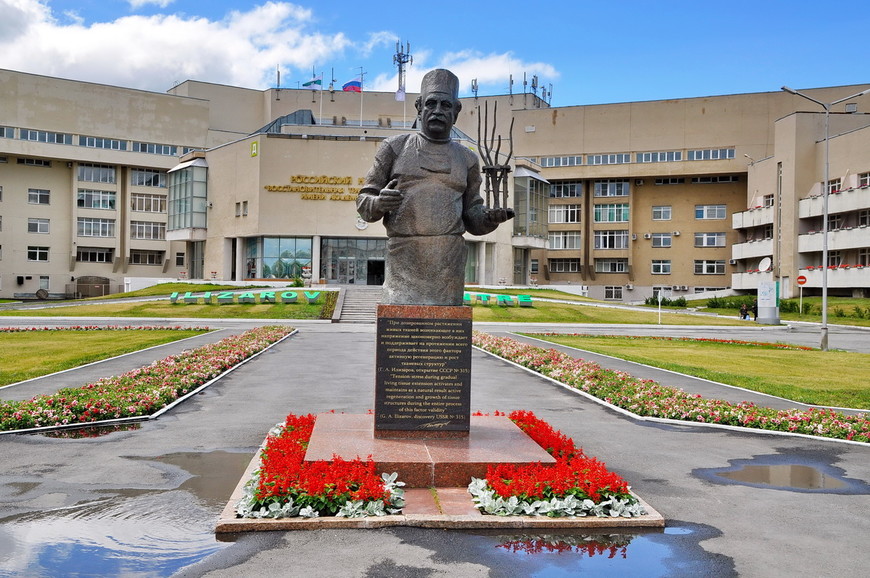The Michelangelo of Orthopedics
Gavriil Abramovich Ilizarov (1921–1992) was a Russian orthopedic surgeon whose groundbreaking work in the field of bone and joint surgery has left an indelible mark on the orthopedic world. Most notably, he is celebrated for developing the Ilizarov External Fixator, a revolutionary device that has transformed the way bone fractures, deformities, and length discrepancies are treated. His innovations not only changed surgical approaches but also saved lives, improved outcomes for patients, and paved the way for further advances in orthopedic care.

Unlike many orthopedic pioneers in developed Western countries, the success of Gavriil Abramovich Ilizarov, the founder of the circular external fixator, has gone through an extremely difficult and tortuous road.
In June 1921, Ilizarov was born in a poor family in the Caucasus of the former Soviet Union. His parents were illiterate, and there were six children. This meant that Ilizarov had no chance to go to elementary school until he was 11 years old. But he completed 8 years of compulsory education in a relatively short period of time, and his grades were always among the best.
In 1939, he began to study medicine at the Crimean Medical College. But as the Soviet Union was involved in World War II in 1941, students were forced to evacuate. He could only continue his studies at the Medical College in Kazakhstan. After graduating in 1944, he was assigned to work in Kurgan, a remote area in western Siberia, where he spent his entire life.
His career began like this. The so-called hospital was just a few wooden houses, and he needed to burn a fire to keep warm to survive the long winter in Siberia. The area where he was located was as large as the entire country of Belgium, but he was the only doctor. It was at this time that he began to come into contact with many patients with lower limb injuries and deformities caused by war injuries.
The simple plaster fixation was disappointing, and Ilizarov thought: There must be a better treatment method. He started with a semi-circular frame and a Steinmann pin, but soon found that two semi-circular frames could be screwed together to form a full-circular external fixator.
In fact, a similar circular external fixator had appeared as early as 1934, and the inventor was American Joseph E. Bittner. But at that time, the external fixator was only used as a fracture reduction device, and the plaster had to be removed after it was applied. There are such treatment methods in the United States and Germany. The understanding of this type of external fixator in the Soviet Union is generally believed to have come from Germany during World War II. Of course, what really made Ilizarov successful was not the external fixator itself, but the theory of external fixator treatment he proposed through years of experiments and clinical observations. The core of the theory is: continuous traction will stimulate bone growth. Under the guidance of this theory, trauma orthopedics, delayed fracture healing, nonunion of fractures, limb lengthening, etc. can all be treated with external fixators.
Interestingly, Ilizarov discovered that the above phenomenon was also due to luck. Once he was on vacation, a patient with nonunion of fracture came to the hospital. The nurse wanted to increase the pressure on the fracture ends to make them contact better, so she adjusted the external fixator. Unexpectedly, she got the rotation direction of the adjustment screw wrong. Instead of being close together, the fracture ends separated. But later X-rays showed that bone callus had grown. This attracted Ilizarov’s attention.
Another time, a patient who had amputated below the knee came to the doctor and asked if there was any way to make his below-knee stump longer so that he could wear a prosthesis. Ilizarov told him that he could first install an external fixator, cut the bone, and pull the ends apart. After 4-5 months, bone grafting was performed between the ends. But after a few months, the patient did not come back to see the doctor. Half a year later, Ilizarov met the patient by chance. The osteotomy site had completely healed, the stump had become longer, and no bone grafting was needed.
In this way, in the early 1950s, Ilizarov perfected the theoretical basis and practical application of his external fixator, but it was unknown to outsiders.
It is said that in 1951, he went to Moscow to demonstrate his theory and external fixator. But the official condition was that the name of the president of the Central Research Institute of Traumatology and Orthopedics should be attached before the patent could be granted. Ilizarov refused and returned to Siberia to work quietly.
This went on for more than 10 years. As the technology became more and more mature and more and more patients were cured, the news would inevitably spread to the Soviet Ministry of Health in Moscow.
In 1965, the official sent a Gorekovsky to Kurgan to investigate. Although the semi-retired doctor had long heard that Ilizarov was a lunatic and that the authorities regarded his achievements as a fraud, the purpose of his investigation was to collect evidence against Ilizarov. However, with his instinct and knowledge as a doctor, he felt that there was something extraordinary there as soon as he arrived at the hospital in Siberia. The conditions in this remote hospital were so difficult, and the work was so outstanding. Gorekovsky reported the truth after returning to Moscow, but the authorities not only did not believe him, but demoted him. Of course, it was not easy for the people in the health department to continue to turn a deaf ear to Ilizarov’s technology.
Someone wrote to the Soviet authorities, asking for Ilizarov’s method to treat diseases. The authorities asked the Ministry of Health whether there was such technology in Moscow, and the Ministry of Health had to say yes. Of course, Ilizarov, who was thousands of miles away, could not be invited, so Gorekovsky had to do it. Ilizarov was sure that he would not cooperate with the authorities, so the Soviet health department made things difficult for him. He lived in a remote corner of Siberia. On the one hand, it was of course his misfortune, which prevented his ideas and techniques from being accepted by the world earlier; on the other hand, it was also his luck. After all, he was far away from official interference and could engage in his medical treatment and research relatively quietly.
In 1967, still by chance, Ilizarov became famous almost overnight because he cured an Olympic high jump champion of osteomyelitis and nonunion. From then on, patients flocked to him. Through writing manuals and teaching materials, his techniques also spread throughout the Soviet Union. At that time, it was in the Cold War era, and the West still had no chance to understand what Ilizarov was doing, even though Ilizarov had performed operations in Cuba, which was only nearly a hundred miles away from Florida.
There was still a coincidence that Ilizarov’s technology spread to the West. In 1980, an Italian explorer was sailing on a ship and somehow developed an infected tibial pseudoarthrosis. The doctor on the ship happened to be a Soviet, and he immediately suggested that he see Ilizarov. When the explorer returned to Italy six months later, Italian doctors were surprised by the unexpectedly good recovery.
This year, Ilizarov set foot on Italian soil. This was the first time he showed his achievements in the Western world. He gave four reports, each lasting two hours. The audience watched those incredible cases with bated breath. The Italians immediately decided to establish the Ilizarov Method Research and Application Association. The Italian media even exaggeratedly called this technology “the second revolution in Russia” and praised Ilizarov as “the Michelangelo of orthopedics.”
In 1987, Frankel and Green became the first American doctors to visit Ilizarov in Siberia. They saw the “Russian Ilizarov Trauma and Orthopedic Reconstruction Science Center”, one of the largest and best trauma orthopedic hospitals in the world.
In his later years, Ilizarov was burdened by his success. He usually saw patients until 2 or 3 in the morning, and patients from all over the country stayed in front of his office for a long time. It was clear that he cared about every patient, but at the same time he could not bear such high intensity work for a long time. There was a back door in his office, and sometimes he slipped out through it.
Before his death, Ilizarov was already a household name in the former Soviet Union, with novels, plays and movies based on him. He also won almost all the highest honors of the country, including the Order of Lenin.

Leading Suppliers of Ilizarov External Fixation
Today, many companies provide external fixators inspired by Ilizarov’s work. These companies offer advanced versions of the original apparatus, improving upon the design and functionality to meet the needs of modern orthopedic care. Here are a few of the prominent suppliers in the field of external fixation.
1.Orthofix Medical Inc.
A global leader in orthopedic devices, offering advanced external fixation systems for limb reconstruction and deformity correction.
2.Smith & Nephew
Provides innovative external fixation solutions, including circular frames for complex orthopedic cases.
3.DePuy Synthes (Johnson & Johnson)
Offers a range of external fixation devices, including modular systems for trauma and limb lengthening.
4.Stryker
Known for its comprehensive orthopedic solutions, including external fixators for fracture management and bone regeneration.
5.Russian Ilizarov Scientific Center
The original institution founded by Ilizarov, continuing to produce and distribute the authentic Ilizarov apparatus.
6.Biomet (Zimmer Biomet)
Provides external fixation devices designed for the stabilization and treatment of fractures. Their products are known for innovation and ease of use in clinical settings.
Conclusion: Legacy of Gavriil Ilizarov
Gavriil Abramovich Ilizarov’s contributions laid the foundation for the development of modern techniques in limb lengthening, bone reconstruction, and deformity correction, influencing the practices of orthopedic surgeons worldwide.His pioneering development of the external fixator system laid the groundwork for future advances in the field, and his legacy endures through the many orthopedic surgeons and companies that have adopted and improved upon his techniques.
For orthopedic professionals, understanding the history of Ilizarov’s innovations is not only important for appreciating the evolution of modern orthopedic techniques, but also for recognizing the significant advances that continue to improve patient care and outcomes today. The availability of advanced external fixators from leading companies ensures that Ilizarov’s principles continue to be applied in clinical practice, providing orthopedic surgeons with the tools necessary to treat even the most complex cases with precision and effectiveness.
As the field of orthopedics continues to evolve, Ilizarov’s contributions remain foundational, offering hope and improved outcomes for countless patients worldwide.
Note:The copyright belongs to the original author and the magazine,posts are for learning and communication only.